Hummingbirds are attracted to feeders that have good nectar recipes, but bees are also attracted to nectar. Understanding how both birds and bees act can help in our feeding dilemma.
But the question remains – how to keep bees away from hummingbird feeders? There are many ways to achieve this without harming birds or bees. Here are the best tips that actually work.
1. Install bee guards
If your hummingbird feeder is bee proof, then that means you will make the feeding holes smaller so that no bees or other insects can get into it. Some hummingbird feeders you buy will come with bee guards already built in place.
The first thing to consider is to buy a proper feeder with a bee guard, but if you already have a feeder, then you can just install a bee guard.

Hummingbirds have long beaks and tongues which are able to reach sources of nectar, mainly from the vault of flowers. Putting on a mesh or bee guard around the feeding ports keeps the bees from passing through the holes, which means they can’t reach the nectar and they will eventually give up pursuing it.
Bees will only call for reinforcements if they have access to the nectar. Otherwise, there won’t be a bee swarm if just a couple investigating bees fail to get the nectar.
2. Use red saucer feeders
Hummingbirds can reach the nectar with their long tongues, but insects can’t. While hummingbirds are attracted to the color red, bees are attracted to the color yellow.
Depending on which type of feeder you get, some types of hummingbird feeders are less insect-friendly than others. With saucer feeders position nectar away from the feeding port, to a point where insects will be unable to reach it.
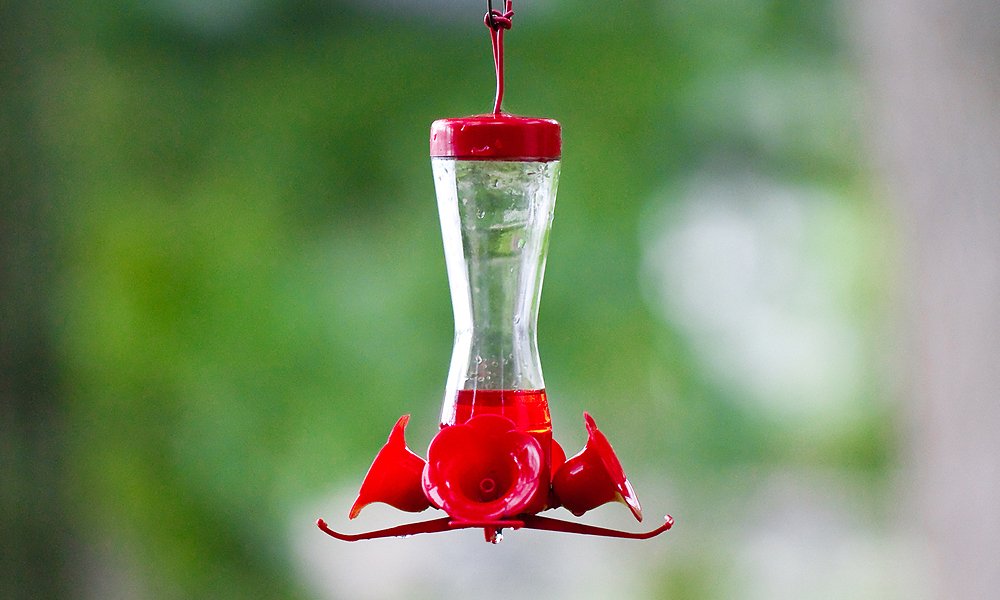
Other feeder designs include built-in ant moats or bee guards that are specifically designed to keep insects from accessing the nectar without stopping the hummingbirds. Extra accessories are available to add to any nectar feeder.
Bees can be guided to a bowl filled with one to two parts sugar and one part water mix. Position a bowl in a place not too far from the hummingbird feeder. Once the bees are attracted to the bowl, move the bowl to a sunny spot a little farther away from the feeder.
3. Relocate the feeder often
Once hummingbirds find a food source, they will frequently visit it and will look around nearby for other food sources. Constantly moving hummingbird feeders can be a useful tactic to create confusion and keep bees away from hummingbird feeders.
While you can move the feeder just a few feet away, there is a chance the bees will find it again quickly. Relocating the feeder too often can result in confusing the hummingbirds as well as the bees, so make sure you have your schedule for moving the feeder rigid but not too rigid.

Most of the time, insects are only likely to visit convenient sources and probably won’t search for relocated hummingbird feeders. Moving the feeder a few feet can minimize visits from insects without discouraging hummingbirds.
If your yard has multiple feeding stations when birders simply switch where different feeders are positioned throughout the yard every time the feeders are refilled, then this will be easy to accomplish. This method will also keep ants away from hummingbird feeders.
4. Use decoy feeders
Having a feeder that is basically a duplicate of your hummingbird feeder but made for bees is an effective way to keep bees away from hummingbird feeders.
Place this bee specific feeder near the hummingbird feeder, and hang this detour feeder in the full sunlight they prefer, and use a sweeter sugar water solution. Anything that is stronger than a 5-to-1 water-to-sugar ratio is effective bee bait.
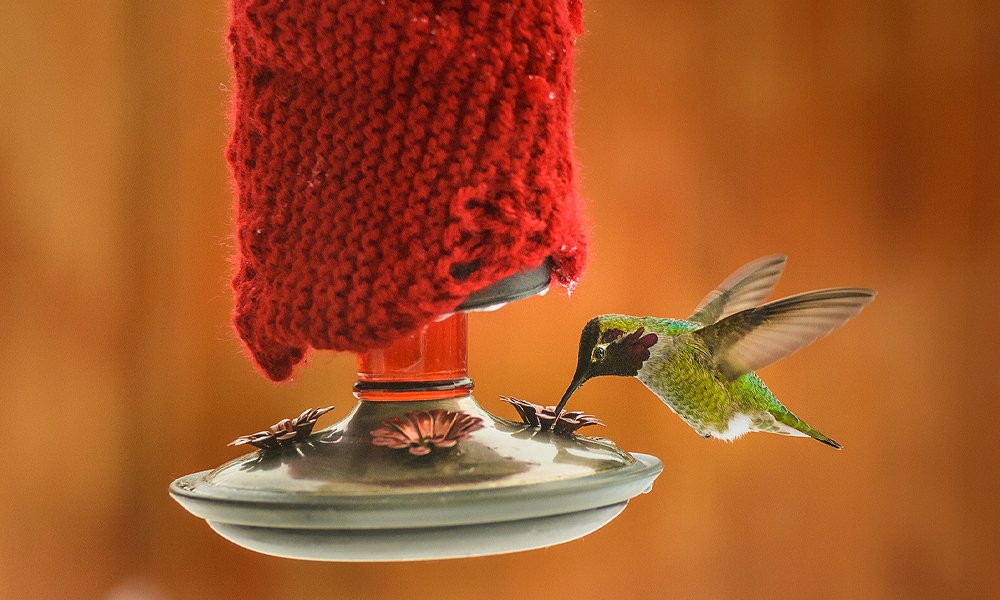
Place a very shallow bowl with this solution about 5 or 6 feet away from hummingbird feeders. You may need to begin closer to the feeder and then move it farther away incrementally. This will keep bees around to pollinate your flowers while giving them an alternative food source.
Always keep in mind that insects will visit the most convenient food sources first, so whether it is just a bowl or another bird feeder, make sure that the feeding source is open enough for the bees to access.
5. Find and stop the leakage
One of the most common reasons why you can’t keep bees away from hummingbird feeders is the leakages that come from the feeders. You can’t afford to let your feeder go unchecked for any slits or leakages.
Dripping sweet sugar water will invite other insects like ants to hummingbird feeders. Having a minor leak occasionally is not a concern, but when the drips and leaks become both consistent and large, then it is necessary to stop the flow.
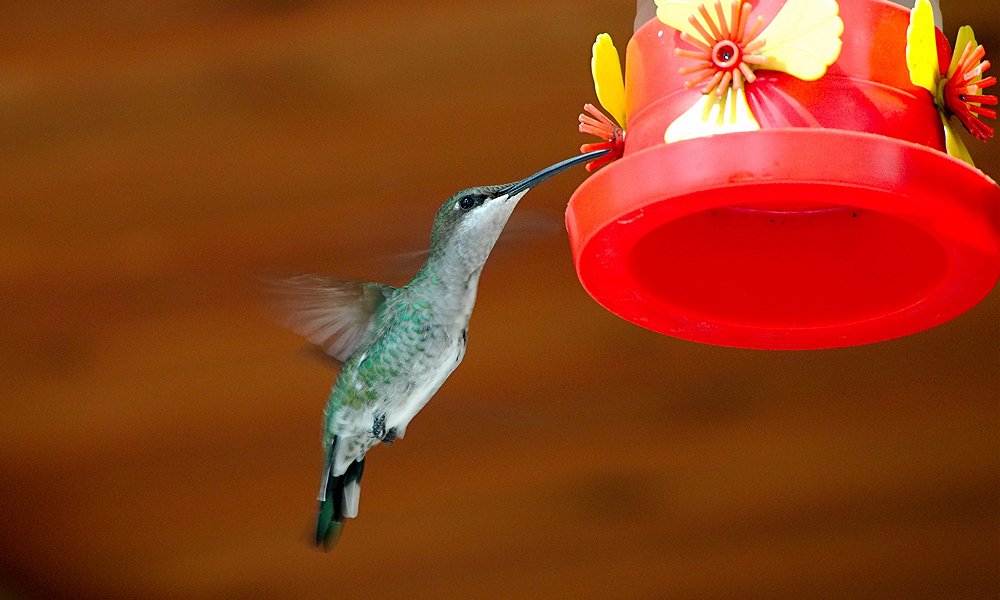
There are several ways to tighten a feeder and reinforce the seals to minimize leakage. A good seal between the bottle reservoir and the feeder ports does the job. A weak or uneven seal will leak easily.
To reinforce a seal, use plumber’s tape over the threads where the feeder screws together to tighten the seal and minimize any existing leaks. Keep the tape out of contact with the nectar to prevent contamination.
6. Make the nectar less sweet
Honey bees are quite partial to sugar, especially sucrose. When there are plenty of nectar sources around, bees will stay away from flowers whose nectar is a little weak on the sugar concentration like pear blossoms.
Since they are after the sugar, it would be a good idea to alter the sugar ration in your hummingbird feeder so that the bees will lose interest in the sugar water. For your hummingbird feeder, try a 5:1 water to sugar ratio.
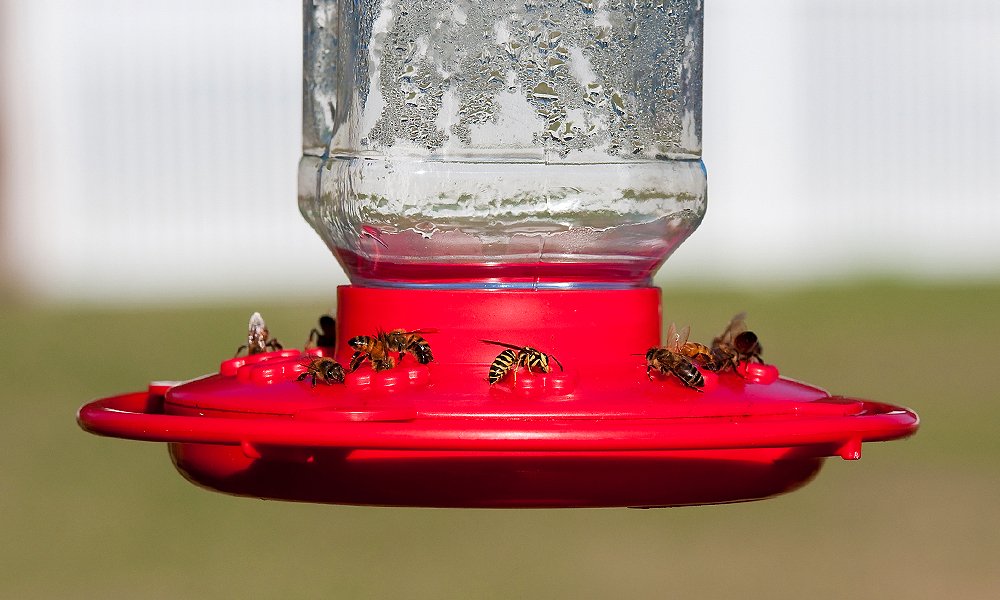
Bees value higher concentrations of sugar, so in their own feeder, provide them with a sugar ratio that suits them. The standard water to sugar ratio for hummingbird feeders is 1 to 4.
Adding just one extra portion of sugar to a bee feeder should do the job. Ideal water to sugar water ratios for bees and wasps and other insects would be to start at 3:1, and then make adjustments whenever necessary.
7. Avoid anything yellow
Due to the color of flowers and other food sources where bees find pollen and nectar, they are naturally attracted to the color yellow. However, they don’t find red as appealing. Avoid having feeders with yellow insect guards or flower accents to minimize the appeal to bees.
If you have a feeder that has yellow anywhere on it, repaint those parts with red, non-toxic paint. A good example of a feeder that discourages bees because it has no yellow on it would be the HummZinger feeder.
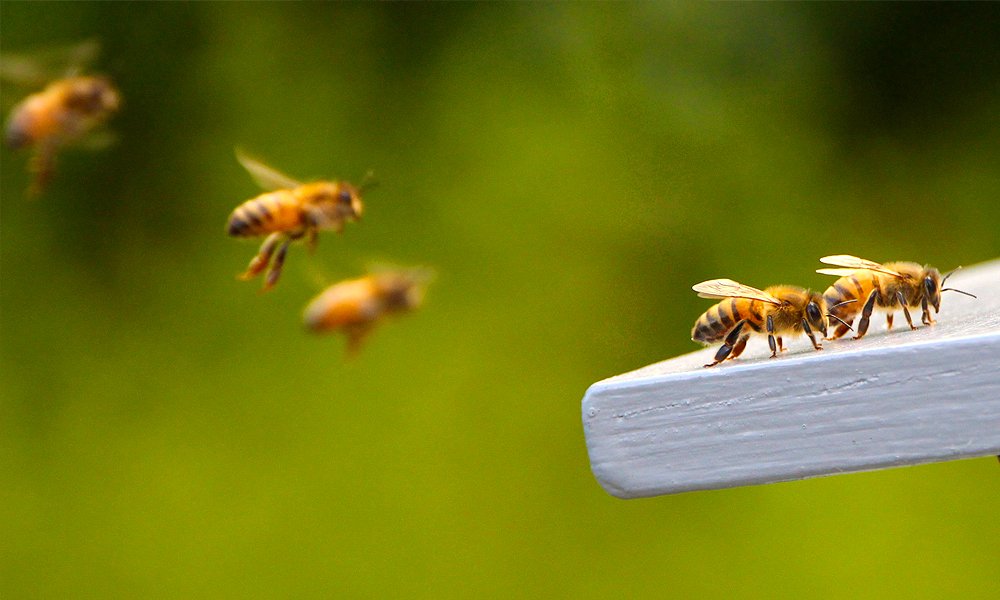
Some colors, like yellow and blue, have more influence on bees than others. Compared to humans, bees see in a slightly different spectrum.
They are able to see into the ultraviolet part of the electromagnetic spectrum that humans can’t see. Because of this type of vision, bees are also unable to see the color red. The color black signals danger for bees, warning them to stay away.
8. Grow a pollinator garden
Bees pollinate over 80% of all flowering plants, including 70 of the top 100 human food crops. Around 1/3 of the food we eat traces back to plants pollinated by bees.
If you have an alternative floral source of nectar that the bees can’t resist, then they will leave the hummingbird feeder alone. You could also use pollinator seeds to plant some flowers for the hummingbirds and enjoy the wonderful hum radiating from your garden.
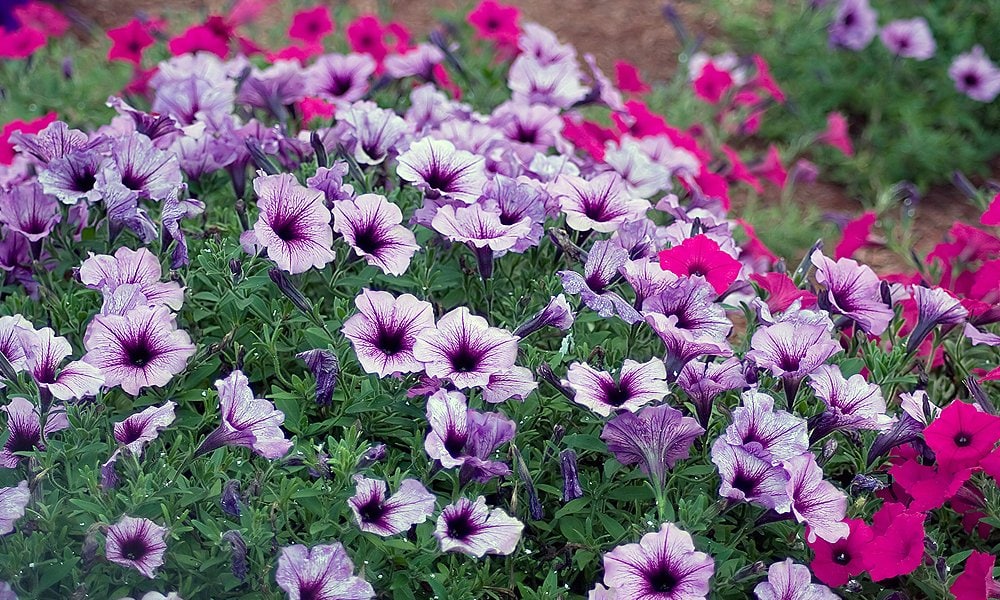
Making a pollinator garden depends on what is suitable for both hummingbirds, and the plants you choose will vary depending on climate, location, and soil type. Mix annuals and perennials and choose flowers with staggered bloom times to ensure abundant food sources as long as possible.
Flowers that attract both hummingbirds and bees alike include Bee Balm, Trumpet Creeper, Petunia, and Zinnia. All of these flowers, except for Bee Balm, feature the color yellow, which attracts bees.
9. Clean the feeder on a daily basis
Drips of nectar will inevitably fall from their bills onto the feeder as birds feed. Hummingbird feeders can also drip if they are filled too full. The nectar is forced out of the feeder because of the air pressure inside.
Every time you refill hummingbird feeders, carefully clean the outside and around the feeding ports to remove any spilled nectar. Also, take time to repair any cracks and replace any parts of the feeder to minimize leaks.
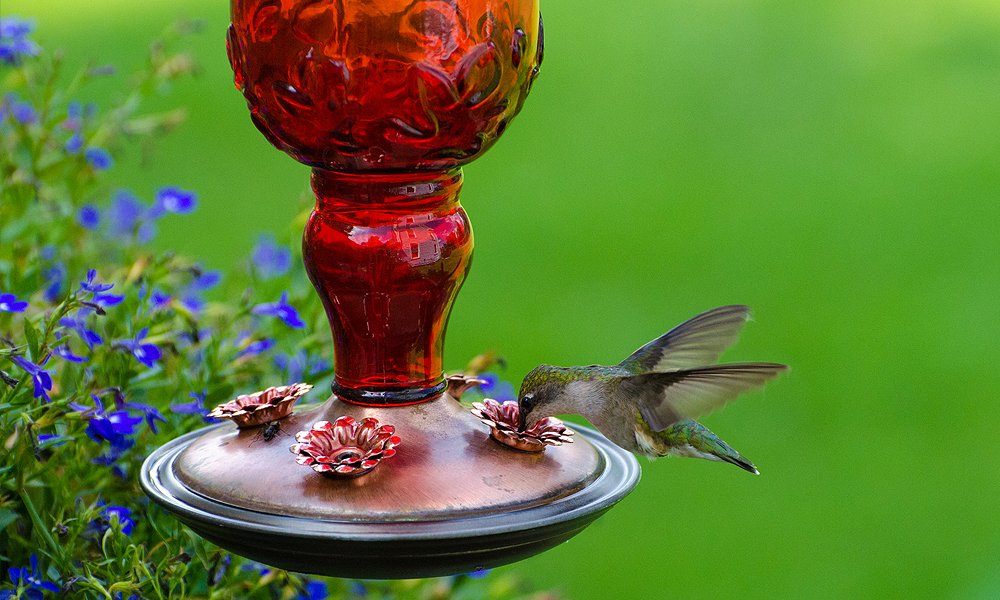
Even if small in size, exposed portions of nectar that form a mess can attract insects to your feeder, including bees. Insects can smell leaked nectar and sticky stains, and they will take advantage of any spills.
It is recommended to clean hummingbird feeders on a daily basis, but this process only takes 30 seconds of your time. Hummingbird feeders are not hard to handle as they have a grateful shape and are more than simple to clean.
10. Try a shaded location
Both hummingbirds and bees will feed on your feeders wherever they are located as long as they are accessible. However, bees are used to looking for pollen and nectar in the sunlight because that is where most flowers bloom from.
By hanging hummingbird feeders in a spot that has some shade, you will make them less attractive to bees. It also helps to hang your feeders in the shade because that will prevent the nectar from spoiling too quickly.
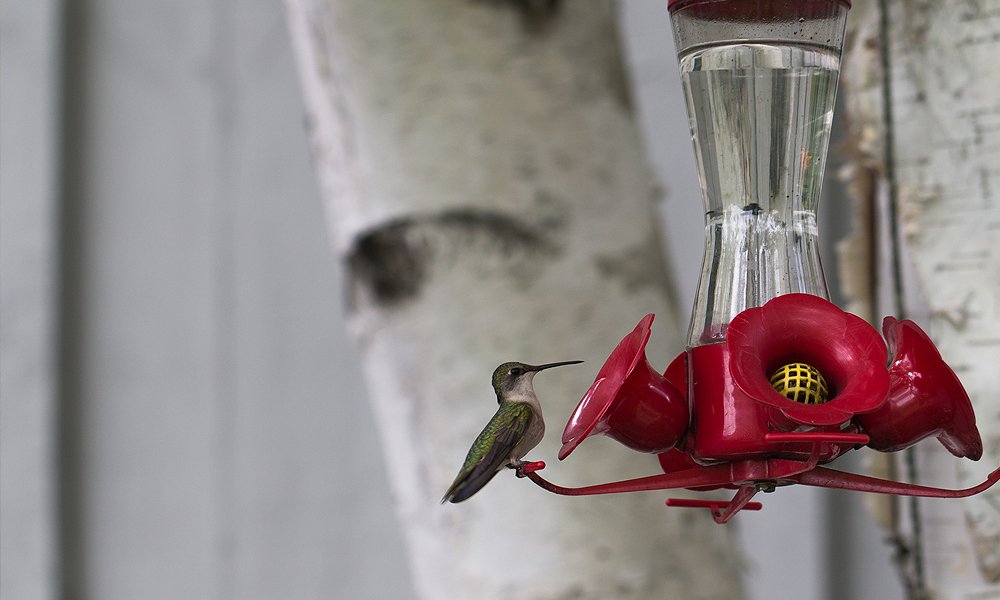
The shade keeps the nectar cool and slows down the fermentation process. Hot weather will expand the feeder if it is made up of plastic and this expansion can result in leakages.
However, it is important to note that keeping hummingbird feeders in a fully dark and shaded area will lose its appeal to hummingbirds because they won’t be able to find it, so the ideal place will be a partially shaded area.
11. Add fake wasps’ nests
Wasps are very territorial and they will instinctively not build any of their own nests near another colony. The presence of a wasp nest would deter bees and other insects from accessing food sources around the nest.
Bees and yellow jackets could move away, thinking that your yard was already taken. If you want your fake wasp nest to appear as real as possible, then make sure the deterrent nest measures in at 8 x 11 inches.
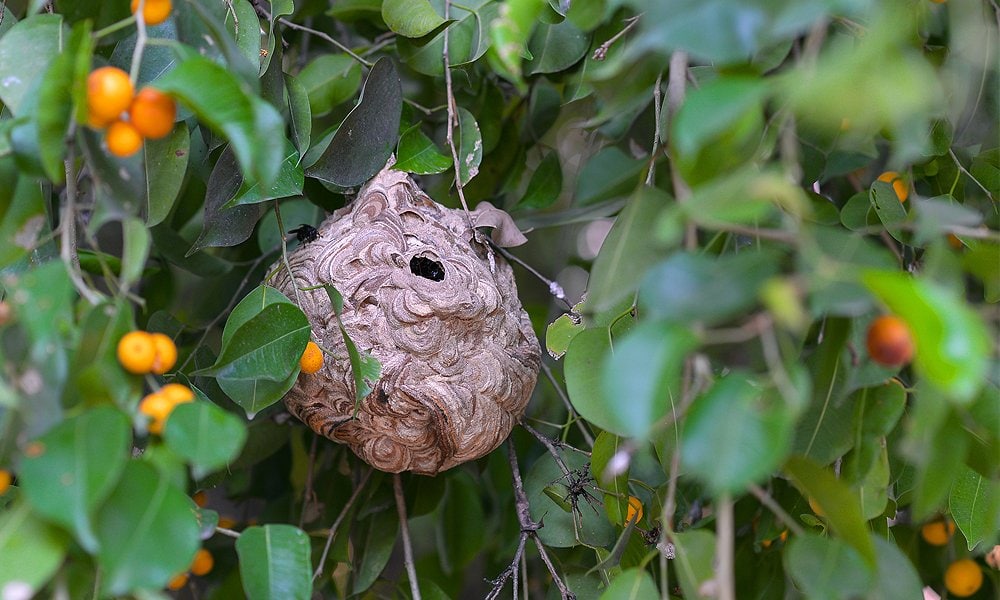
It is important to note that wasps like yellow jackets will mainly nest on or in the ground, which means that sometimes they won’t care about the fake wasp nests hanging outside the home.
Yellowjackets are very aggressive and will almost never be deterred by a fake nest as they will gladly get close to inspect it. However, fake nests are effective deterrents, especially in the early spring months, when they start looking for new locations to settle in.
12. Consider insect traps
While we want to keep bees away from hummingbird feeders, the reality is that bees are not bad by themselves. They serve as great aids to your garden via pollinating and they create sweet food sources in honey.
Commercial insect traps are available to reduce insect populations in your yard. It is recommended to use these traps sparingly because you don’t want to disrupt the insects’ place in your yard’s ecosystem.

Hummingbirds and many other wild birds eat insects, so it isn’t recommended to spray insecticides or oils that kill bees and wasps, and other insects or to place any harmful chemicals inside traps. Insecticides and oils can contaminate the nectar and potentially harm hummingbirds.
Only choose traps that will target the most problematic insects and remove traps as soon as the hummingbird feeder is no longer being troubled. Having too many traps can drastically destroy important insect populations.

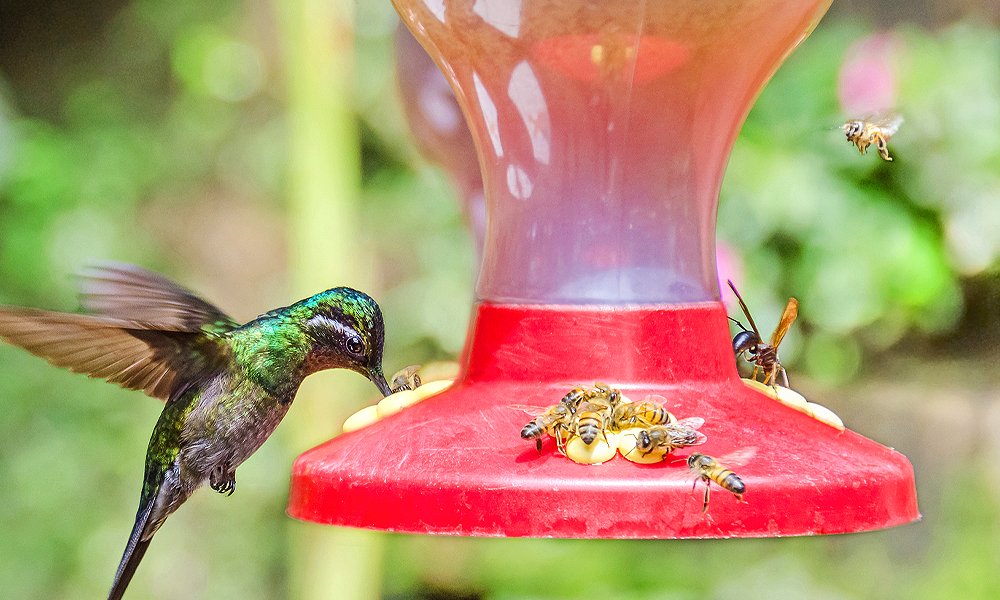
took out yellow covers on hummingbird feeder,wash really good.Bees are gone and hummingbirds can drink out of red tube on feeder,so far good.
If the color yellow attracts bees, why are the bee traps for hummingbird feeders yellow? Maybe pink or green would be a better color to deter the bees.
Exactly! I came to this article for advice and was wondering the exact same thing!
I have enjoyed watching hummingbirds for many years and have multiple feeders on my upstairs porch. Since moving from the Adirondacks to the North Carolina mountains. I have experienced dealing with more yellow jackets, bumble bees, and hornets (the worse!), than I ever did. I have ants too, but usually get rid of them by using diametrous earth.
I have tried using all of your suggestions, and not one of them has worked. And I tried to stick with the suggestions for weeks.
I tried the sugar water in the bowl, which only seemed to draw more bees and hornets to my porch, I moved the feeders around routinely & it only took the bees a few minutes to find the new places. I have a lovely rose and flower garden on the side of my house, full of pollinators. It does not keep the bees and hornets away from my feeders, they aggressively feed on both the flowers and feeders. I clean my feeders every day, I use hornet traps, most are too smart for them. I also use bee guards, but the nasty critters still seem to find a way to get to the sugar water.
This year I’m going to try planting mint type herbs in special flower boxes next to my feeders, plus all geraniums in my regular flower boxes on my porch-maybe this will help deter the bees and hornets a bit. This has been a very frustrating and sad battle for me. Last summer a hornet killed one of the precious little hummers!🙁
Aww poor hummingbird
I have the same problem with bees, wasps and ants… I’m still searching for solutions. Good luck with your search!!
Let us know how that goes! I’m interested. I’m a retired teacher and this sounds like an exciting science experiment to me.
Do humming machines attract bees? Yes, because when the bees find a food source, they get in, the hummingbird likely won’t eat there and it will look for another food source. This is why we have to keep bees away from hummingbird feeding places. Some ways to keep bees away from hummingbird feeding places are: Using a red feeder for hummingbird food will attract more hummingbirds while discouraging bees. Use a dish-shaped hummingbird feeder for the hummingbird’s long beak. Or use nectar protection tips, preventing bees and other sweet-loving insects from accessing the nectar.
As someone who enjoys watching birds a lot more than watching bees, I don’t want bees to get to the hummingbird feeders I put out. This is why I devised ways to keep bees away from my hummingbird feeders.
I tried to copy and paste your image, but it wouldn’t: I have the feeder in your 11th image from the top, yellow perforated bulbs and all. My wasp trap worked very well for a while, but now European honey bees have found it, and my hummers have abandoned it. I don’t want to hurt the bees, so I moved the wasp trap away.
If all it takes is a long stem to keep the nectar out of the bees reach, the feeder in your third image is mine except with different feeding ports, and no yellow. It should work, and you said something near there about swapping out parts? They screw in and out? Cool. Do you know where I can buy either those feeding ports, or that feeder?
Thanx!
Oops. Honey bees found my feeder, not the wasp trap.
Thanks for the information. I took my feeders down because of the yellow jackets. I will try what you have suggested. I hope the little hummers will return.
Your article has many information helpful to a newbie like me on hummingbird feeders. I successfully drove away bees from the feeder by washing it. I have only one feeder and will be adding more as I find the hummingbirds quite fascinating. I am grateful for your efforts in providing us useful information and will be reading more of them. Thank you.
Wonderful advice. No yellow flowers on the feeder for the hummingbirds. Place a sweeter 3 to 1 sugar potion in a distracting feeder with yellow flowers out for the bees. I will try your advice. Thank You, Cindy
This was so informative and gave me multiple ideas to help both species stay happy and healthy. I’m looking forward to reading any and all articles on birds and the like since I found this one! Thanks so much!
Outstanding article and eye-opening info. Please keep doing you’re doing ! Thnx.
Thanks for the information. I learned so much and will continue to visit and read your info.